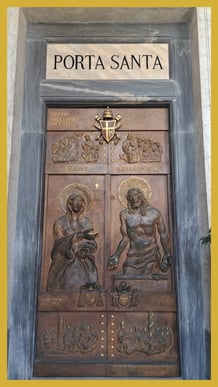The Holy Door
Contents
History and Meaning of the Holy Door
Opening of the Holy Door
Holy Doors in Rome and International Locations
The Holy Door is a symbol of profound significance within the Catholic Church, closely associated with the Jubilee, a special time for forgiveness and spiritual renewal.


History and Meaning of the Holy Door
The tradition of the Holy Door dates back to Pope Celestine V in 1294, who declared the door of the Basilica of Santa Maria di Collemaggio in L'Aquila as venerated. The opening of this door during the Jubilee, in a ritual known as the Celestinian Pardon, transcends a mere liturgical act, serving as a compelling invocation of forgiveness and spiritual renewal—a theme that resonates through the Jubilee celebrations to this day.
During the Jubilee, the Holy Door serves as a symbolic gateway enabling the faithful to receive special indulgences and reaffirm their commitment to spiritual growth. Its importance is deeply rooted in biblical and theological traditions, symbolizing a transformative journey from earthly life to spiritual life, embodying purification and renewal. Each opening marks a time of exceptional grace and a call to both personal and communal conversion.
The symbolism of the Holy Door is profound and multifaceted. In biblical terms, a door often represents a transition and access—from the secular to the sacred, from mortality to immortality, from isolation to communion. Within the Jubilee context, the Holy Door acts as a figurative passage for the faithful, marking their transition from a state of sin to one of grace, from estrangement from God to a closer union with Him.
Opening of the Holy Door
Traditionally, the Holy Door is opened at the start of the Jubilee, held every 25 years or during special occasions proclaimed by the Pope. The opening ceremony, led by the Pontiff, takes place with a symbolic ritual at St. Peter's Basilica.
Historically, the Pope would strike the sealed door three times with a silver hammer. In recent times, however, the ceremony has adopted a more symbolic approach, foregoing the physical breaking of a seal to highlight the unceasing accessibility of God’s mercy.
Explore the ritual of the Holy Door's opening in our dedicated article.
Le Porte Sante a Roma e nel mondo
While the four major Roman basilicas are central to this tradition, other Holy Doors around the world invite the faithful to partake in the Jubilee experience, reflecting the Catholic Church's universality.
The Four Major Roman Basilicas:
Other Holy Doors Around the World:
Cathedral of Santiago de Compostela: The cathedral features a Holy Door, opened during Compostela's holy years, welcoming pilgrims on the Camino de Santiago.
Basilica of Notre-Dame de Québec: This basilica in Canada houses a Holy Door, the first of its kind outside Europe.
Cathedral of the Sacred Heart in New Delhi: This cathedral in India opened its Holy Door during the Jubilee of Mercy.
This translation aims to not only maintain fidelity to the original text but also enhance readability and convey the profound cultural and spiritual nuances associated with the Holy Door and its traditions within the Catholic Church.The Holy Door is a powerful symbol of renewal and redemption within the Catholic Church. When it opens in Rome and elsewhere around the world during the Jubilee period, these occasions are of profound spiritual import, drawing pilgrims from every corner of the globe, all eager to experience personally the abounding mercy and the earnest call to conversion extended by the Church.
Drop us a line
Follow us
Discover the Jubilee
Experience the Jubilee
Jubilee locations
Get ready for the Jubilee
Rome and the Jubilee
